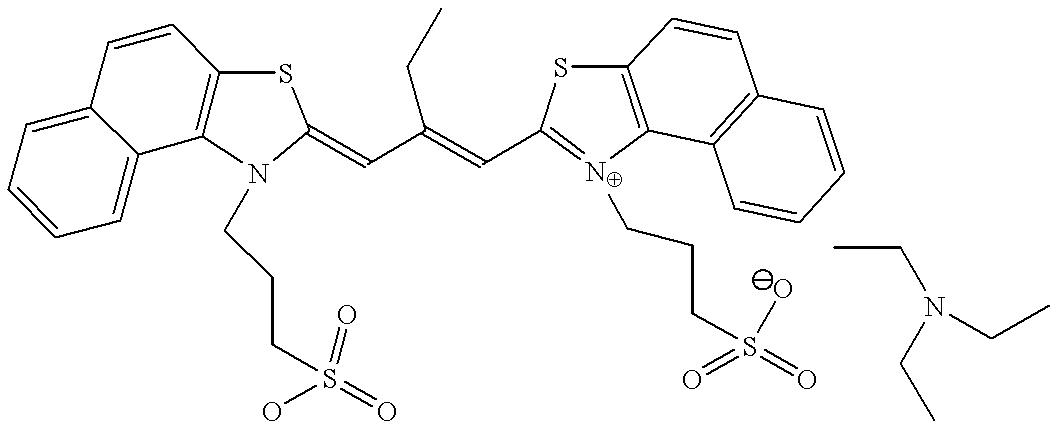Phosphoric acid ester surface modifiers for silver carboxylate nanoparticles
a technology of silver carboxylate nanoparticles and phosphoric acid ester, which is applied in the field of photothermographic materials, can solve the problems of large crystals, inability to provide the desired improved properties, and difficulty in preparing these photothermographic silver halide materials
- Summary
- Abstract
- Description
- Claims
- Application Information
AI Technical Summary
Problems solved by technology
Method used
Image
Examples
example 2
[0122] This is a Comparative Example
[0123] Aqueous Photothermographic Imaging Element Formulated Using Microparticulate AgBeh Dispersion.
[0124] A photothermographic element was formulated, coated, exposed and heat processed as described in Example 1 except that the nanoparticulate dispersion of Example 1 was replaced with the microparticulate dispersion of Preparation 2. The resulting sensitometric curves show that the element of the invention is about 0.2 Log E faster than the microparticulate dispersion.
[0125] Preparations 3-14
[0126] An aqueous nanoparticulate silver behenate colloidal dispersion was prepared as described in Preparation 1 except that the Emphos.TM. CS-1361. dispersing aid was replaced by dispersing aid listed in Table 5.
[0127] The mean particle sizes for these dispersions were determined in the manner described in Example 1 and are reported in Table 5.
5TABLE 5 Prep- % Mean ara- Sufac-Milling Milling Particle tion Surface tant vs. Time Temp. Size # Modifier Source ...
preparation 15
[0128] Preparation 15
[0129] Preparation of an Aqueous Nanoparticulate Silver Behenate (AgBeh) Colloidal Dispersion Using Controlled Precipitation
[0130] A 18 liter reactor was charged with 9.97 kg of water, 363 g of 1.87% aqueous solution of Emphos.TM. CS-147 surfactant, and 279.6 g of behenic acid. The contents were stirred at 150 RPM with an anchor stirrer and heated to 70.degree. C. Once the mixture reached 70.degree. C., 390.7 g of 10.85% aqueous potassium hydroxide were added to the reactor. The mixture was heated to 80.degree. C. and held there for 30 minutes. The mixture was then cooled to 70.degree. C. When the reactor reached 70.degree. C., 1000 g of 12.77% aqueous silver nitrate were fed to the reactor in 5 minutes. After the addition, the nanoparticulate silver behenate was held at the reaction temperature for 30 minutes. It was then cooled to room temperature and decanted. A silver behenate dispersion also containing 9% by weight of behenic acid based on silver behenate, ...
example 3
[0132] Aqueous Photothermographic Imaging Element Formulated Using Nanoparticulate AgBeh Dispersion Made Using Controlled Precipitation
[0133] A photothermographic in element similar to that disclosed in Example 1 was prepared using a silver behenate dispersion as described in Preparation 15.
[0134] A coating mixture suitable for preparing an aqueous photothermographic imaging layer comprising an aqueous nanoparticulate AgBeh dispersion prepared as described in Preparation 15 was prepared by combining 162.79 grams of 7% aqueous solution of polyvinyl alcohol (PVA, Elvanol.TM. 52-22 86-89% hydrolyzed (Dupont)) with 110.37 grams of nanoparticulate silver behenate dispersion of Preparation 15. To this mixture was added 2.85 grams of succinimide, 1.87 grams of 185 g / l of an aqueous solution of sodium iodide, and 3.29 g of 4 g / l aqueous solution of mercuric bromide. The mixture was stirred overnight. A primitive iodobromide cubic emulsion, Br.sub.97I.sub.3, 57 nanometer in edge length, and ...
PUM
| Property | Measurement | Unit |
|---|---|---|
| Percent by mass | aaaaa | aaaaa |
| Temperature | aaaaa | aaaaa |
| Fraction | aaaaa | aaaaa |
Abstract
Description
Claims
Application Information
 Login to view more
Login to view more - R&D Engineer
- R&D Manager
- IP Professional
- Industry Leading Data Capabilities
- Powerful AI technology
- Patent DNA Extraction
Browse by: Latest US Patents, China's latest patents, Technical Efficacy Thesaurus, Application Domain, Technology Topic.
© 2024 PatSnap. All rights reserved.Legal|Privacy policy|Modern Slavery Act Transparency Statement|Sitemap



